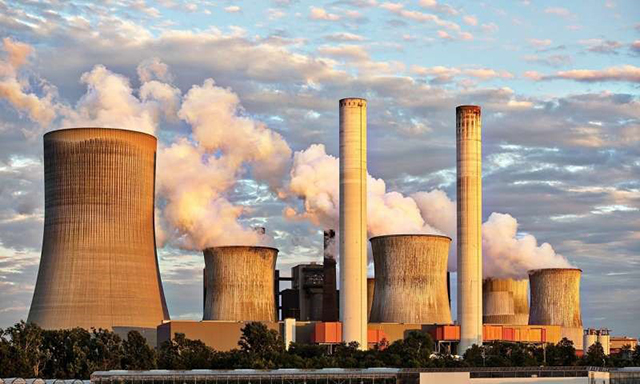
Turkey produced 66% of its electricity from local and renewable resources in the first five months of 2020, the country's Energy and Natural Resources Minister Fatih Donmez said Wednesday.
"We continue to reap the fruits of our long-term investments," Donmez wrote on Twitter, given that Turkey wants to fully utilize local and renewable energy resources efficiently to support its development and to reduce dependence on energy imports. Last year Turkey's electricity production from local and renewable resources stood at 62%, he noted. But on May 24, Turkey saw an all-time daily record as local and renewable resources accounted for 90% of the country's electricity generation, the minister added.
"The target is clear: Much more local, and much more renewables," Donmez asserted.
The minister also detailed the share of each resource out of the 66% total: 34.3% was generated from hydroelectricity, 13.8% from local coal, 8.8% from wind, 3.6% from geothermal, 3.5% from solar, 1.8% from biomass and 0.2% from other sources.
On May 24, hydro plants constituted the largest portion at 43.7%, while local coal plants contributed 16.5% to electricity generation. Wind plants powered 14.5% and solar plants constituted 7.2%. Geothermal and biomass plants added 5.3% and 2.6%, respectively.
Donmez recently said around 70% of Turkey's additional capacity in the last five years had come from domestic and renewable energy resources. In just over a decade, Turkey has tripled its installed renewable capacity to around 45,000 megawatts and invested nearly $40 billion in renewable energy projects. Turkey ranks sixth in Europe and 13th in the world in terms of renewable capacity.
According to data from the International Energy Agency (IEA), Turkey's renewable energy capacity of 42 gigawatts (GW) is predicted to reach 63 GW by 2024, placing Turkey among Europe's top five and 11th worldwide in terms of renewable capacity.
Source: Daily Sabah

The trade volume of Turkey's day-ahead spot electricity market increased by 4.31% in May compared to the same month of 2019, according to data provided by Turkey's Energy Exchange Istanbul (EXIST).
The trade volume in the day-ahead spot electricity market, which EXIST started to operate in 2015, registered at about 2.6 billion liras in May compared to around 2.5 billion liras in May 2019.
EXIST reported transactions in the day-ahead market in May of 12.6 million megawatt-hours. The highest trade volume on a daily basis was recorded on May 20 at 141.4 million liras, while the lowest occurred on May 24 with 9.3 million liras.
In May, the average electricity rate for one megawatt-hour in the day-ahead spot market was calculated as 203.22 liras. Turkey's energy exchange company, responsible for operating energy trade, including power and gas commodities, provides counter-party guarantees in its transactions.
US$1 equals 6.72 Turkish liras at 0515 GMT on Wednesday
Source: AA

Guidehouse Insights has named the leading commercial and industrial energy storage systems integrators.
ENGIE, Enel X, Tesla, Honeywell, Con Edison Battery Storage, EDF, and NantEnergy have been named as leaders in Guidehouse Insights’ Leaderboard report.
The top energy storage systems integrators are playing multiple roles through turnkey services or strategic partnerships to drive down costs and enable financing innovation, according to the report.
Ricardo F. Rodriguez, a research analyst with Guidehouse Insights, said: “Each company has established an access-to-customers advantage to reduce the costs of customer acquisition and uses a comprehensive energy storage software platform that analyses project costs and forecasts project revenue streams.”
The demand for onsite renewable energy generation continues to increase as more and more cities commit to carbon reduction goals. This in turn is increasing the demand for distributed energy storage systems as energy stakeholders seek cost savings, grid support, and other bottom-line benefits.
As competitition among vendors intensifies, the field of pure-play distributed energy storage systems integrators is in flux.
During the past 2 years, companies have started shifting focus away from the origination and development of projects to acting as pure-play integrators that provide integrated hardware and software solutions, according to the study.
Source: Smart Energy International

The plunge in fossil fuel prices and consumption caused by the Covid-19 pandemic this year is set to bring down global fossil fuel consumption subsidies to USD 180 billion in 2020, which would be the lowest annual figure since the IEA started tracking the data in 2007.
The lockdowns and economic slump have brought market-based fuel prices closer to the artificially low end-user prices that prevail in many countries, decreasing the value of the subsidy per unit of consumption. Lower consumption in many countries has further reduced the estimate, notably the major reduction in transport activity. The lower estimate for 2020 comes on the back of a significant decline in fossil fuel consumption subsidies in 2019, for which detailed country-by-country data are now available in the IEA’s Energy Subsidies database.
Periods of low fuel prices typically represent a golden opportunity to pursue the pricing reforms that are the only durable way to eliminate consumption subsidies.
Countries that are net importers of fuels find it politically easier to phase out subsidies when prices are low, as the adjustment to end-user prices (and impact on inflation) is smaller. A plunge in oil prices also adds urgency to domestic pricing reforms in major oil and gas producing nations, where fossil fuel consumption subsidies are generally concentrated.
In these cases, the abrupt falls in hydrocarbon revenues in 2020 mean that reforms to wasteful fuel subsidies become a crucial way to relieve fiscal strains.
The overriding economic priority for policy makers so far in 2020 has been to limit the damage from the crisis: governments are providing direct and indirect support to keep households and companies afloat. As such, there are few signs so far that low fuel prices are prompting an accelerated effort to phase out subsidies, although pre-existing reform efforts have continued. In some countries, there have been examples of the opposite tendency, particularly in the electricity sector, as governments have stepped in with additional price interventions to protect newly vulnerable consumers.
As economic conditions improve, there needs to be a redoubling of efforts to phase out fossil fuel subsidies to ensure that recoveries are sustainable. This would not exclude well-targeted protection for the poorest and most vulnerable groups – as successful subsidy reform efforts around the world have demonstrated. But it would prevent countries with artificially low fossil fuel prices from locking in a new cycle of market distortions that favour polluting and inefficient technologies. Fossil fuel consumption subsidies are in place in more than 40 countries around the world, according to the price-gap methodology used by the IEA in its assessment.
There can be good reasons for governments to make energy more affordable, notably in pursuit of important social goals like universal access to modern energy. But in practice, many subsidies are often poorly designed and targeted – creating structural risks to government budgets and the financial performance of the energy sector, encouraging wasteful consumption among wealthier segments of the population, and pushing up emissions across economies as a whole.
These subsidies create a roadblock to a cleaner and more efficient energy future. That is why the IEA has consistently been shining a spotlight on this issue and continues to be a strong supporter of international efforts to get them removed.
There has been only fitful progress on subsidy phase-outs in recent years. IEA tracking of subsidy-related policy announcements highlights good examples of countries (such as India, Tunisia and Egypt) reinforcing this pillar of sound energy policy-making, and other countries announcing their intention to follow suit. But they also show multiple examples of policy reversals or postponements, with the protection afforded to consumers coming at significant fiscal and environmental cost.
Source: IEA

The United Kingdom has put forward its own new UK-wide Emissions Trading System (ETS) to replace the European Union’s system for trading carbon emissions, which Britain will leave at the end of this year as the Brexit transition period ends.
The UK-wide ETS, which will put a cost on carbon pollution to encourage polluters to reduce the greenhouse gases they emit, includes plans to cut the present emissions cap by 5%, Britain’s Department for Business, Energy and Industrial Strategy said in a statement.
“We have procured a supplier who is building the registry – the main IT system for the UK ETS,” the statement added.
The United Kingdom has a target for net zero carbon emissions by 2050.
Emissions trading systems work by setting a cap on the total amount of greenhouse gases that can be emitted from certain sectors, with the cap being reduced over time so that total emissions fall.
“After each year, every covered company must surrender enough carbon allowances – each representing tonnes of carbon dioxide – to cover all its emissions, or additional fines of up to £100 per allowance are imposed,” the department said.
About one-third of UK emissions and nearly 1,000 UK factories and plants are currently covered by the EU ETS and will continue to be covered by the UK system, according to the statement.
The British government said on Monday it would be open to considering a link between a UK ETS and the EU ETS “if it suits both sides’ interests”.
“This is subject to the ongoing trade negotiations between the UK and EU,” the government said.
According to the government’s draft plans, a minimum auction price would apply during the first phase of the new system, in order to reduce the chances of discrepancies between the new market and the EU ETS.
European lawmakers have suggested that if the UK fails to sing from the same hymn-sheet on carbon pricing, Brussels would consider resorting to a still-pending carbon border tax to prevent carbon leakage of industries from the mainland to Britain.
Source: Euractiv

Renewable power is increasingly cheaper than any new electricity capacity based on fossil fuels, a new report by the International Renewable Energy Agency (IRENA) published today finds.
Renewable Power Generation Costs in 2019 shows that more than half of the renewable capacity added in 2019 achieved lower power costs than the cheapest new coal plants.
The report highlights that new renewable power generation projects now increasingly undercut existing coal-fired plants. On average, new solar photovoltaic (PV) and onshore wind power cost less than keeping many existing coal plants in operation, and auction results show this trend accelerating – reinforcing the case to phase-out coal entirely. Next year, up to 1200 gigawatts (GW) of existing coal capacity could cost more to operate than the cost of new utility-scale solar PV, the report shows.
Replacing the costliest 500 GW of coal with solar PV and onshore wind next year would cut power system costs by up to USD 23 billion every year and reduce annual emissions by around 1.8 gigatons (Gt) of carbon dioxide (CO2), equivalent to 5% of total global CO2 emissions in 2019. It would also yield an investment stimulus of USD 940 billion, which is equal to around 1% of global GDP.
“We have reached an important turning point in the energy transition. The case for new and much of the existing coal power generation, is both environmentally and economically unjustifiable,” said Francesco La Camera, Director-General of IRENA. “Renewable energy is increasingly the cheapest source of new electricity, offering tremendous potential to stimulate the global economy and get people back to work. Renewable investments are stable, cost-effective and attractive offering consistent and predictable returns while delivering benefits to the wider economy.
“A global recovery strategy must be a green strategy,” La Camera added. “Renewables offer a way to align short-term policy action with medium- and long-term energy and climate goals. Renewables must be the backbone of national efforts to restart economies in the wake of the COVID-19 outbreak. With the right policies in place, falling renewable power costs, can shift markets and contribute greatly towards a green recovery.”
Renewable electricity costs have fallen sharply over the past decade, driven by improving technologies, economies of scale, increasingly competitive supply chains and growing developer experience. Since 2010, utility-scale solar PV power has shown the sharpest cost decline at 82%, followed by concentrating solar power (CSP) at 47%, onshore wind at 39% and offshore wind at 29%.
Costs for solar and wind power technologies also continued to fall year-on-year. Electricity costs from utility-scale solar PV fell 13% in 2019, reaching a global average of 6.8 cents (USD 0.068) per kilowatt-hour (kWh). Onshore and offshore wind both declined about 9%, reaching USD 0.053/kWh and USD 0.115/kWh, respectively.
Source: IRENA
World Energy Investment 2020
The worldwide economic shock caused by the Covid-19 pandemic is having widespread and often dramatic effects on investments in the energy sector. Based on the latest available data, the International Energy Agency's World Energy Investment 2020 provides a unique and comprehensive perspective on how energy capital flows are being reshaped by the crisis, including full-year estimates for global energy investment in 2020.
Please click here to read the full report.

